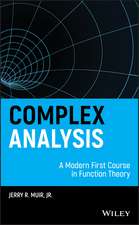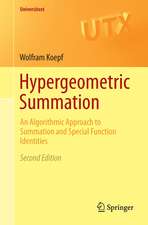Neural Fields: Theory and Applications
Editat de Stephen Coombes, Peter beim Graben, Roland Potthast, James Wrighten Limba Engleză Paperback – 23 aug 2016
| Toate formatele și edițiile | Preț | Express |
|---|---|---|
| Paperback (1) | 650.37 lei 6-8 săpt. | |
| Springer Berlin, Heidelberg – 23 aug 2016 | 650.37 lei 6-8 săpt. | |
| Hardback (1) | 656.74 lei 6-8 săpt. | |
| Springer Berlin, Heidelberg – 9 iul 2014 | 656.74 lei 6-8 săpt. |
Preț: 650.37 lei
Preț vechi: 765.14 lei
-15% Nou
Puncte Express: 976
Preț estimativ în valută:
124.46€ • 129.78$ • 103.44£
124.46€ • 129.78$ • 103.44£
Carte tipărită la comandă
Livrare economică 20 martie-03 aprilie
Preluare comenzi: 021 569.72.76
Specificații
ISBN-13: 9783662515112
ISBN-10: 3662515113
Pagini: 497
Ilustrații: X, 487 p. 132 illus., 50 illus. in color.
Dimensiuni: 155 x 235 x 26 mm
Greutate: 0.69 kg
Ediția:Softcover reprint of the original 1st ed. 2014
Editura: Springer Berlin, Heidelberg
Colecția Springer
Locul publicării:Berlin, Heidelberg, Germany
ISBN-10: 3662515113
Pagini: 497
Ilustrații: X, 487 p. 132 illus., 50 illus. in color.
Dimensiuni: 155 x 235 x 26 mm
Greutate: 0.69 kg
Ediția:Softcover reprint of the original 1st ed. 2014
Editura: Springer Berlin, Heidelberg
Colecția Springer
Locul publicării:Berlin, Heidelberg, Germany
Cuprins
Preface.- 1.Tutorial on Neural Field Theory. S. Coombes, P. beim Graben and R. Potthast.- Part I Theory of Neural Fields.- 2.A Personal Account of the Development of the Field Theory of Large-Scale Brain Activity from 1945 Onward. J. Cowan.- 3.HeavisideWorld: Excitation and Self-Organization of Neural Fields. Shun-ichi Amari.- 4.Spatiotemporal Pattern Formation in Neural Fields with Linear Adaptation. G.B. Ermentrout, S.E. Folias and Z.P. Kilpatrick.- 5.PDE Methods for Two-Dimensional Neural Fields. C.R. Laing.- 6.Numerical Simulation Scheme of One- and Two Dimensional Neural Fields Involving Space-Dependent Delays. A. Hutt and N. Rougier.- 7.Spots: Breathing, Drifting and Scattering in a Neural Field Model. S. Coombes, H. Schmidt and D. Avitabile.- 8.Heterogeneous Connectivity in Neural Fields: A Stochastic Approach. C.A. Brackley and M.S. Turner.- 9.Stochastic Neural Field Theory. P.C. Bressloff.- 10.On the Electrodynamics of Neural Networks. P. beim Graben and S. Rodrigues.- Part II Applications of Neural Fields.- 11.Universal Neural Field Computation. P. beim Graben and R. Potthast.- 12.A Neural Approach to Cognition Based on Dynamic Field Theory. J. Lins and G. Schöner.- 13.A Dynamic Neural Field Approach to Natural and Efficient Human-Robot Collaboration. W. Erlhagen and E. Bicho.- 14.Neural Field Modelling of the Electroencephalogram: Physiological Insights and Practical Applications. D. T. J. Liley.- 15.Equilibrium and Nonequilibrium Phase Transitions in a Continuum Model of an Anesthetized Cortex. D.A. Steyn-Ross, M.L. Steyn-Ross, and J.W. Sleigh.- 16.Large Scale Brain Networks of Neural Fields. V. Jirsa.- 17.Neural Fields, Masses and Bayesian Modelling. D.A. Pinotsis and K.J. Friston.- 18.Neural Field Dynamics and the Evolution of the Cerebral Cortex. J.J. Wright and P.D. Bourke.- Index.
Textul de pe ultima copertă
With this book, the editors present the first comprehensive collection in neural field studies, authored by leading scientists in the field - among them are two of the founding-fathers of neural field theory. Up to now, research results in the field have been disseminated across a number of distinct journals from mathematics, computational neuroscience, biophysics, cognitive science and others. Starting with a tutorial for novices in neural field studies, the book comprises chapters on emergent patterns, their phase transitions and evolution, on stochastic approaches, cortical development, cognition, robotics and computation, large-scale numerical simulations, the coupling of neural fields to the electroencephalogram and phase transitions in anesthesia. The intended readership are students and scientists in applied mathematics, theoretical physics, theoretical biology, and computational neuroscience.
Neural field theory and its applications have a long-standing tradition in the mathematical and computational neurosciences. Beginning almost 50 years ago with seminal work by Griffiths and culminating in the 1970ties with the models of Wilson and Cowan, Nunez and Amari, this important research area experienced a renaissance during the 1990ties by the groups of Ermentrout, Bressloff, Haken, and Wright. Since then, much progress has been made in both, the development of mathematical and numerical techniques, and in physiological refinement and understanding.
In contrast to large-scale neural network models described by huge connectivity matrices that are computationally expensive in numerical simulations, neural field models described by connectivity kernels allow for analytical treatment by means of functional analysis methods. Thus, a number of rigorous results on the existence of bump and wave solutions or on inverse kernel construction problems are nowadays available. Moreover, neuralfields provide an important interface for the coupling of continuous neural activity to experimentally observable data, such as the electroencephalogram (EEG) or functional magnetic resonance imaging (fMRI). And finally, neural fields over rather abstract feature spaces, also called dynamic neural fields, found successful applications in the cognitive sciences and in robotics.
Neural field theory and its applications have a long-standing tradition in the mathematical and computational neurosciences. Beginning almost 50 years ago with seminal work by Griffiths and culminating in the 1970ties with the models of Wilson and Cowan, Nunez and Amari, this important research area experienced a renaissance during the 1990ties by the groups of Ermentrout, Bressloff, Haken, and Wright. Since then, much progress has been made in both, the development of mathematical and numerical techniques, and in physiological refinement and understanding.
In contrast to large-scale neural network models described by huge connectivity matrices that are computationally expensive in numerical simulations, neural field models described by connectivity kernels allow for analytical treatment by means of functional analysis methods. Thus, a number of rigorous results on the existence of bump and wave solutions or on inverse kernel construction problems are nowadays available. Moreover, neuralfields provide an important interface for the coupling of continuous neural activity to experimentally observable data, such as the electroencephalogram (EEG) or functional magnetic resonance imaging (fMRI). And finally, neural fields over rather abstract feature spaces, also called dynamic neural fields, found successful applications in the cognitive sciences and in robotics.
Caracteristici
Written by leading scientists in the field Includes contributions from two of the founding-fathers of neural field theory: Shun-ichi Amari and Jack Cowan The first comprehensive collection of results in the research area of neural field theory



















